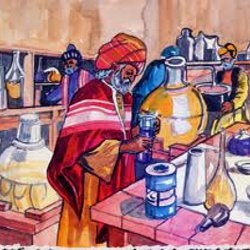On Saturday, March, 10th, 2012, in the assembly hall of the Islamic Cultural City Centre of Kiev took place a scientifically-educational theater presentation “The Golden Age of Islam” on motives of a short-film presentation of an exhibition “1001 invention” in London, Great Britain. Representation for children was prepared by young Muslims with support of female department of the social organisation "An-Nur".
In the beginning there appeared Avitsenna (Abu Ali ibn Sina, 980 — 1037), who belongs to the number of the greatest scientists of Central Asia, —a philosopher and physician, a scientist and mathematician, a poet and literary critic. His name enters into the galaxy of great thinkers of the mankind. In the beginning of the 11th century he assumed existence of viruses, described a set of heart diseases, studied pulse and blood vessels, diseases of ears, stomach, teeth, hygiene problems, described physiotherapy exercises and gymnastics role.
"Ibn Sina" also told about his colleague from Cordoba, “father of surgery” Albukassis az-Zahrawi. His “Encyclopedia of Surgery” served as a standard working material in the subject in all universities of Europe during five hundred years. “At-Tasrif” is the illustrated book on medicine and surgery, intended for students of medical colleges and practicing doctors for whom it was an irreplaceable friend and assistant in various inconvenient situations as in this encyclopedia it was possible to receive answers practically on all questions on clinical problems. “At-Tasrif” contains the earliest in the history drawing of surgical tools. About two hundred drawings are illustrated and described. In places of use of the tool the procedure of surgical operation is represented.
Then the place of Ibn Sina was occupied by Maryam al-Astrolabi, who for the first time carried out work on improvement of astrolabe, the Ancient Greek invention for definition of day and night length for any day of a year. On her investigations works of Muslim scientists were based; as a result the device was improved to the extent that it could be named the most ancient prototype of the computer. Astrolabe turned to compass and navigator symbiosis; used for some mathematical and astrological calculations. Thanks to this "pra-computer" was calculated the time of sunrise and sunset for any day in a year and any district; with its help Muslims defined "qibla” — the direction to Makkah — at building of mosques worldwide.
Appeared Ibn al-Haysam, “the father of optics”, started to consider one of digital cameras, — the invention based on the principle for the first time described by him action of “camera obscura”. He by practical consideration proved inconsistency of views of Platon and Evklid about light as beams which are let out by an eye and "feel" subjects, having put forward his own theory: “natural light and colour beams influence an eye”, and “the vision is obtained by means of beams which are let out by visible bodies and get to an eye”. He considered that to each point of an observable subject can correspond a perceiving point of an eye.
The attention of the present was drawn by an exclamation: “Part, I can fly!” — and Abbas ibn Farnas "flew by" the hall. In 852 he made wings of a fabric tense on wooden sticks. With this device which looked like an umbrella Abbas ibn Farnas jumped off from a minaret of the Great Mosque in Cordoba. The flight was not successful, however, the device slowed down his falling, and he got only insignificant injuries. Twenty five years later, 65-year-old ibn Farnas developed the improved project which included the flight control adaptation — a steering tail. On this first hang-glider he flew down a mountain Dzhabal al-'Arus, and performed a ten-minute operated flight.
His story was interrupted by the great scientist, the engineer and mechanic al-Dzhazari, who laid down the foundation for modern robotics. He invented such an important mechanical detail as a cranked shaft. Moreover, he designed valved pumps, water hoist engines, a water-clock, fountains, musical automatic machines. Certain popularity got four humanoid robots which al-Dzhazari set in a boat and forced to play drums and cymbals. During monarchical parties they were usually started into a lake, and those played plain songs. This scientist possesses such technological innovations, as: wood lamination, use of scale models (the scientist made them of paper), grinding in of moving parts by means of corundum, metal doors, coded locks, etc.
“The father of chemistry”, Dzhabir bin Hayyan (721–805), who drew attention of the spectators by his demonstration of chemical reaction with a bright flash spoke last. He came up with his pioneering idea on huge energy hidden in atom; about possibility of its splitting; that the power which can destroy Bagdad is thus formed. He also mentioned the scientist ar-Razi, who in 860 carried out the first classification of chemical elements; described devices and adaptations for chemical experiments. “Bin Hayyan” did not forget about sultan Mehmet al-Fatih, who invented a pneumatic gun especially for the siege of Constantinople. Excursion came to an end, and the cleaner started to disperse the late visitors. And the mentioned persons are only “iceberg top” in the whole galaxy of great Muslim scientists and their inventions which became the basis of modern science and mechanics.
To fasten the acquired knowledge, children and their parents were invited to participate in quizzes, in which each of scholars set some questions on his biography and discoveries. Children were divided in two teams — boys and girls; for adults there was a separate quiz with more difficult questions. For each right answer his author was awarded by soap which in due time was also invented by Muslims. In the end of the evening the spectators were invited to a sweet treatment where all interested persons could take photos with the "scientists".
Staff reporter.



